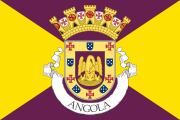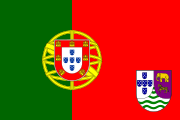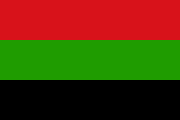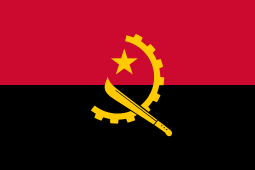 | |
| Use | National flag |
|---|---|
| Proportion | 2:3 |
| Adopted | 11 November 1975; 49 years ago (1975-11-11) |
| Design | A horizontal bicolour of red and black, with a yellow half gear wheel crossed by a machete and crowned with a star in the center. |
| Designed by | Henrique de Carvalho Santos António Alberto Neto |
 | |
| Use | Presidential standard |
| Proportion | 2:3 |
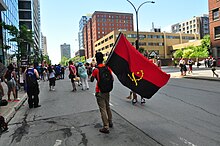
The national flag of Angola came into use when the nation gained independence from Portugal on 11 November 1975. It is split horizontally into an upper red half and a lower black half with an emblem resting at the center. It features a yellow half gear wheel crossed by a machete and crowned with a star.
Description
The National Flag of the Republic of Angola has two horizontal bands of red and black with the Machete and Gear Emblem in gold in the center consisting of a five pointed-star within a half gear wheel crossed by a machete (resembling the hammer and sickle used on the Soviet flag). As outlined in the Constitution of Angola, the red half of the flag signifies bloodshed – during Angola's colonial period, independence struggle, and in defense of the country. The black half symbolizes Africa. In the central emblem, the gear represents industrial workers and production, the machete represents peasantry, agricultural production and the armed struggle, and the star, shaped like the red star, symbolizes international solidarity and progress. The yellow color of the emblem symbolizes the country's wealth. The Constitution of 1975 described the red stripe as symbolizing bloodshed during the colonial period, national liberation and a revolution – and reference to revolution was replaced with "defense of the country" in the constitution of 1992. In other changes of wording between the 1975 and 1992 versions, the star was changed from a symbol of "internationalism" to "international solidarity", and references to "working class" and "peasant class" were replaced with "workers" and "peasants".
Colors
| Red | Yellow | Black | |
|---|---|---|---|
| CMYK | 20/100/90/0 | 0/15/100/0 | 10/10/10/100 |
| Pantone | 186 C | 116 C | Process Black C |
| RGB | 205/2/43 | 255/204/0 | 0/0/0 |
| Hexadecimal | #CD022B | #FFCC00 | #000000 |
Construction Sheet
History
Pre-independent
Angola was founded in the 16th century as a colony of the Kingdom of Portugal. Throughout the colonial period, the only official flag was the frequently changed flag of Portugal. It was only in the 20th century that the adoption of flags representing the colonies was proposed twice. The first series was designed in 1932 by the founder and president of the Portuguese Institute of Heraldry, Afonso de Ornelas, commissioned by the General Agency of the Colonies. Neither the flag nor the coat of arms were ever officially used.
The second proposal was put forward in 1965, when all Portuguese colonies have been integrated into the metropolis as overseas provinces. This proposal consisted of a national flag with an additional coat of arms of Angola on the flying side. The coat of arms has been official since 1935.
War of Independence
In the early 1960s, the Angolan War of Independence broke out. The war against the Portuguese administration was waged by five organizations: FNLA (founded in 1954), MPLA (1956), FLEC (1963), UNITA (1966) and RDL (1973). Of these 5 organizations, the MPLA became the ruling party and their flag became the basis for the flag adopted on independence day on November 11, 1975. The MPLA flag has a yellow star in the center on a horizontal red and black background. It was created in 1959 by António Alberto Neto and was adopted by the party in 1960. In November 1975, a rival government, the Democratic People's Republic of Angola, was also established. The DPRA was controlled by the FNLA and UNITA and did not use the flags associated with the MPLA with which it fought during the civil war.
History of the current flag
The flag was designed by Henrique Onambwé. The process of cutting and sewing the first version of the flag was done by Joaquina, Ruth Lara and Cici Cabral on November 11, 1975. The flag has not changed since then.
Proposed changes
Angola considered adopting a new flag in the 1990s. The proposed design, discussed since September 1996, consisted of three horizontal stripes: red, green and black, combining the colors of the MPLA and UNITA parties and providing Pan-African colors. According to a 1998 report, the National Assembly of Angola began work on a new constitution and planned a competition for a new flag.
In 2003, a new, more "optimistic" flag that dropped the Communist imagery was proposed by the Parliament's Constitutional Commission of the National Assembly (Angolan Parliament), but it was not adopted, and the proposal was suppressed by the ruling party. The sun design in the middle is meant to be reminiscent of cave paintings found in Tchitundo-Hulu cave near Virei. The flag maintained the same flag proportions of 2:3.
See also
References
- Flags of the world (2nd ed.). Buffalo, New York: Firefly Books. 2012 . p. 26. ISBN 978-1-77085-157-3.
- ^ Flags: The visual guide to more than 300 flags from around the world. New York City: Dorling Kindersley. 1998. p. 96. ISBN 0-7894-4224-8.
- "The Flag of Angola". flagdb.com. Retrieved 14 May 2024.
- Constitution of the Republic of Angola (PDF). Luanda, Angola. 21 January 2010. Annex I. Archived from the original (PDF) on 1 June 2019. Retrieved 16 May 2020.
{{cite book}}: CS1 maint: location missing publisher (link) - Lei Constitucional da República Popular de Angola (PDF) (in Portuguese). 1975. Article 54. Archived from the original (PDF) on 6 July 2021. Retrieved 16 May 2020.
- Constitutional Law of the Republic of Angola (PDF). 1992. Article 162. Archived from the original (PDF) on 5 July 2021. Retrieved 16 May 2020.
- "Símbolos Nacionais da República de Angola: Manual de Normas Gráficas e Protocolares". www.governo.gov.ao. Archived from the original on 1 September 2019. Retrieved 20 June 2019.
- "Província Ultramarina de Angola".
- Hermínio Escórcio: O MPLA tinha um Plano B, mas preferiu pôr de lado Archived 30 October 2022 at the Wayback Machine. Jornal de Angola. 11 November 2020.
- Berry, Bruce. "Angola - proposals for a new flag". crwflags.
- "República de Angola - Assembleia Nacional - COMISSÃO CONSTITUCIONAL". Wayback Machine. Government of Angola. Archived from the original on 7 December 2003. Retrieved 12 July 2024.
- Wayback Machine. Govt. of Angola https://web.archive.org/web/20031212125352/http://www.angola.org/referenc/proposed_flag.html. Archived from the original on 12 December 2003. Retrieved 12 July 2024.
{{cite web}}: Missing or empty|title=(help)
External links
| Flags of Africa | |
|---|---|
| Sovereign states |
|
| States with limited recognition | |
| Dependencies and other territories |
|
| Angola articles | |||||
|---|---|---|---|---|---|
| History | |||||
| Geography | |||||
| Politics | |||||
| Economy | |||||
| Society |
| ||||
| National flags and coats of arms | |
|---|---|
| National flags | |
| National coats of arms | |

